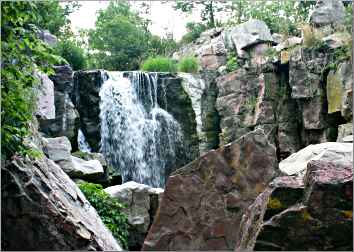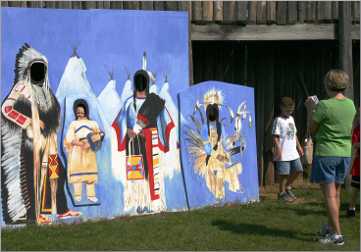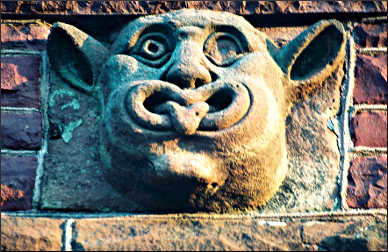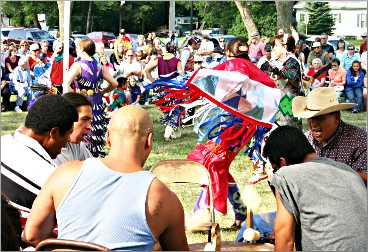Pipestone pilgrimage
For centuries, the quarries have been a sacred spot in this southwest Minnesota town.

© Beth Gauper
It's easy to see why the Plains Indians saw the Great Spirit at work in a far corner of Minnesota.
Amid an ocean of tall grass, a fractured pile of hard red rock suddenly erupts from the sod. It's Sioux quartzite, once sand at the edge of a red ocean, cooked and pressed into marble-like stone over a billion years.
Beneath the quartzite is a thin seam of a softer stone, a red, hardened clay that's barely harder than a fingernail.
This is pipestone, mined for centuries by people of many tribes, who carved into effigies and pipes called calumets, whose smoke carried messages to the Great Spirit.
Artist George Catlin, the first European to see the quarry, recorded a Dakota account of its origin: the Great Spirit, in the form of a large bird, called all the tribes together and, forming a pipe from the stone, smoked it and told all his children its stone was their flesh, and the grounds from which it came sacred.
Some tribes believed the quarry was where the Great Spirit created man, and others that he sent a flood to cleanse the Earth, and that the pipestone is the blood that remains.
Some believed it was uncovered by the hooves of a white bison; others by the great spirit of thunder.
Catlin's accounts of the rare stone engaged the imaginations of others, too, far beyond Minnesota's borders. In 1855, Henry Wadsworth Longfellow penned the hit poem "Song of Hiawatha," mixing Iroquois and Ojibwe legends with Victorian romanticism and setting it to the meter of a Finnish epic poem.
It began, "On the mountains of the prairie/On the great red pipe-stone quarry/Gitche Manito, the mighty/He the master of life, descending/On the red crags of the quarry/Stood erect, and called the nations/Called the tribes of men together."
The 23-part poem put Pipestone on the map, drawing a stream of tourists that never has stopped.
Today, the quarries are protected as part of Pipestone National Monument and are worked only by enrolled members of tribes, in the traditional way-by hand, after a prayer.
Still, there are those who treat pipestone as if it were no more sacred than gravel.
As visitors turn into the monument drive, past the souvenir shop Fort Pipestone, they see a sign-a few bucks a pound for pipestone that's hacked out of a private lot with a backhoe.

© Beth Gauper
All around Pipestone, Indian culture exists cheek-by-jowl with European culture. Across from the monument entrance, three granite boulders sit, fragments of a 50-foot boulder carried down from Canada by a glacier.
These Three Maidens are considered the dwelling place of spirits who guard the quarries, and Indians who visit often tuck offerings of tobacco or sage into their crevices.
Just a few yards away, brightly colored bleachers and concession stands surround a small pond, part of an old quartzite quarry.
The "Song of Hiawatha" pageant, first staged in 1949 by townsfolk in fringed buckskin and braided wigs, once brought 10,000 spectators to Pipestone over three summer weekends. In 2008, it was performed for the last time.
Before the townsfolk started putting it on, it was performed by the eighth-grade graduating class of the Pipestone Indian Training School, one of the boarding schools to which children were sent to "unlearn" Indian language and customs.
The school closed in 1953, and now is Southwestern Technical College.
Just down Hiawatha Avenue, a giant peace-pipe sits outside the 1890 cream-brick Rock Island Depot. This is the home of the Keepers of the Sacred Tradition of Pipemakers, who promote American Indian traditions and public awareness of them.
Some feel pipestone should be used only for sacred purposes, by Indians. But others, like the Keepers, feel pipestone objects are invested with sacred meaning only when they have been blessed for ceremonial uses, and that exposure to the traditions helps white people understand and respect Indian culture.
Among those the group honors is Joe Taylor, a college-educated Santee Dakota who spent his summers carving pipes in front of the railroad depot and selling them up and down the aisles of trains that passed through.
All paths lead eventually to Pipestone National Monument, established in 1937. There's an eight-minute slide show in the interpretive center, and tribal artisans often demonstrate carving techniques.
From there, the mile-long Circle Trail leads past small operating pits and stands of sumac, whose pithy wood is hollowed out and used as pipe stems. Then stacks of quartzite begin to push through the earth.
One lone column is called Leaping Rock, from which young men proved their valor by jumping six feet to another ledge.
On one mound are initials from the first official visitors, members of the 1838 Nicollet Expedition, which produced the first accurate map of the Upper Mississippi region.

© Beth Gauper
"This admirable hill awaits the poet and the painter, who should visit it when the last rays of the setting sun are falling upon it," cartographer Joseph Nicollet said of the quarry area.
Nearby, Inscription Rock still bears the names of pioneers who visited a half-century later.
The trail continues through an arched stairway and above Winnewissa Falls, Winnewissa being the Dakota word for "jealous maiden."
From the other side, there's a view of a rugged profile jutting from the quartzite-the Oracle, whom tribal shamans believed could talk.
This red and pink rock, as hard and grainy as the pipestone is soft and smooth, has given the town of Pipestone a handsome downtown, with 20 quartzite buildings on the National Register of Historic Places.
The 1888 Historic Calumet Inn, the town meeting place since frontier boom days, is made of it.
So is the 1896 Leon Moore Building, whose namesake not only owned a quarry but could sculpt its stone-the façade includes a dozen sandstone gargoyles, including an ogre blowing a raspberry and a jester wrinkling his nose.
An 1897 stone building next door houses the Pipestone Performing Arts Center, and around the corner is one of the most ornate buildings, its 1896 quartzite facade topped by stepped gables.
Once City Hall, it's now the home of the Pipestone County Museum, whose galleries include the accouterments of white settlers and local tribes, including items used in the movie "Dances With Wolves" and by Civil War soldiers from the area.
Upon quartzite, the pioneer culture was built, and upon pipestone, the Indian culture.
Trip Tips: Pipestone, Minnesota
Pipestone National Monument: It's open daily. For quiet strolls, arrive early or late; it's open till 8 p.m. on summer weekends. Admission is $3 per person, $5 for vehicles; free for American Indians and children 15 and under.
For more about the quartzite in Pipestone and also nearby Blue Mounds State Park and the Jeffers Petroglyphs, see Road trip: Southwest Minnesota.

© Beth Gauper
2023 events: June 24, Water Tower Festival.
Accommodations: The GrandStay Hotel & Suites has an indoor pool and offers a free breakfast. It also lends bikes.
The Historic Calumet Inn on Main Street has struggled for many years and closed in May 2022.
There's camping seven miles southwest of Pipestone at Split Rock Creek State Park.
Dining: There's a Pizza Ranch on Main Street.
Nightlife: Pipestone Performing Arts Center on Main Street hosts theater performances by the Calumet Players as well as concerts and other events.
Recreation: The Family Aquatic Center has slides, one a 126-foot body flume slide, and geysers.
Bicycling: The first five miles of the Casey Jones State Trail are paved east of Pipestone. The trailhead is just north of the junction of I-75 and Minnesota 23.
The trail also includes a six-mile loop between Lake Shetek State Park and the town of Currie, home of the End-O-Line Railroad Park and Museum.
Information: Pipestone tourism, 800-336-6125.